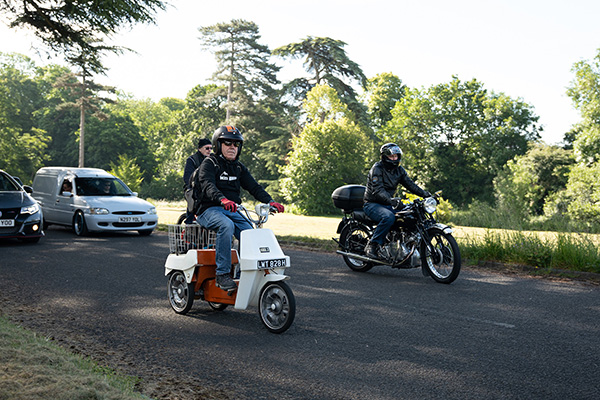10th September
In your mind's eye the first time you transport your classic motorcycle looks pretty simple: rent a van, bit of rope, job's a good 'un.
Until you actually get round to doing it.
Giles Ernsting, 41, learnt the hard way: back in the early 2000s he wrestled his 1981 BMW R100RS into a van, put it on its side stand, tied it down - and then there was that heart-stopping sound behind him of the bike falling over after he hit a bump and the stand collapsed.
Lesson learnt. But nearly 20 years on learning has paid off: he and his team at Moving Motorcycles now transport 4,000 bikes a year, including the likes of rare Vincents - and even a £1million-plus ex-Valentino Rossi MotoGP bike.
That perhaps puts him in pole position to pass on tips about how to move your classic around safely and securely.
"We do all the logistics for the auction houses, so we're there, providing our services to some buyers and sellers while sitting and watching the people who (are loading and transporting bikes themselves) undertake an utter disaster next to us," he said.
He winces. A kind version of what he says he sees as prides and joys are being loaded into rented vans or onto trailers and secured with completely inappropriate methods is that it can be pretty alarming.
First and foremost, he says some people can be shocked at the weight of a bike they're trying to load themselves. Hauling a 200kg-plus machine up a plank on your own can be dangerous. Enlist help, at least one other person, and use a designed-for-purpose motorcycle ramp. You'll pick one up for less than £50 - a sound investment.
"Once loaded, the unseen damage, especially with '80s and '90s bikes, with fairings, when they're putting straps across the fairings and it's bending the struts underneath and everything...." He shudders.
"We use front wheel chocks when we're loading bikes into vehicles. It's all very well strapping a bike down, but ultimately, if it takes a shock from the vehicle that you're carrying it in, then wheels can just slip out from underneath the bike. If you've got a bike in a front wheel chock, it stops that from happening."
So tip number one is to invest in a wheel chock. Cost? From around £30.
"It also makes the whole process of strapping your bike in easier as well, because you've got a little bit of assistance from the chock whilst you're working around the bike."
Next is to carefully consider where to run and attach straps - which need to be proper ratchet straps designed for the job. Prices start at around £15-£20 for a set of four - which is the minimum number you need.

"So much safer. We'd normally use four points of contact on a bike for about 99% of the machines we transport. Four points is sufficient with suitable rated straps as well," he says.
"Some of the really, really big things, Gold Wings and Electra Glides, or even the very big choppers, we might use six because of the flex in the bikes and so they need better securing.
"We usually go from the top of the forks or fork yokes and then to the point to which we secure them, going forwards and out, and then it's the rear. A lot of the time it's wherever you can get a suitable point, but ideally from some kind of secure position around the rear foot pegs, on a part of the sub-frame there.
"You might have to go down to the swinging arm, but that should be sufficient as well."
If you don't use a chock, then experienced owners will get their bike on board van or trailer and rest it on the side stand before deploying straps and tightening them so the bike adopts a vertical position.
In that case, you need to ensure it can't move. Yes, put it in gear, but use something like a cable tie to hold the front break on - being careful not to leave marks on sometimes original throttle grips.
A bigger risk, though, is over-securing a bike with too-tight straps, with some super-nervous owners cranking things down to the full extent of suspension travel - but that can both cause suspension damage and blow seals on parts of the bike which are not meant to be under continuous lengthy stress or compression.
He also says fuel tanks should be checked and sealed, and, ideally, with older machines emptied.
"You sometimes get barn-find bikes in particular where there's been an attempt to get it started, but the fuel tank is completely rotted through and that fuel starts leaking, or from old fuel lines that have given and up the ghost, which then becomes a bit of a worry."
But then there's the unseen worry: insurance. Non-specialist "man with van" operators may mean well and be otherwise professional, but it's hit and miss whether the driver has experience moving motorcycles.
They may have insurance to cover their cargo, but it's sometimes not specific to motorcycles - and, of course, if you're moving an uninsured machine in a van or trailer, then it's likely to be just that: uninsured if anything goes wrong.
It's always worth checking with your insurer precisely what is covered...

COMMENT